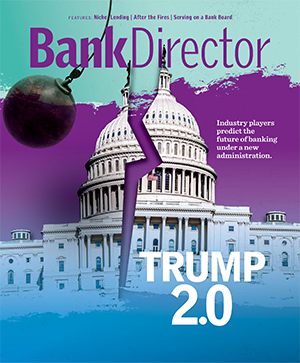Dean Jenkins is Q2’s Principal Digital Strategist. Dean has more than 15 years of experience working both at banks and fintech companies where he developed in-depth knowledge of digital solutions that enable banks and credit unions to grow and deepen primary financial relationships. He plays a key role in establishing Q2 product strategies that are aligned with market needs and ensuring that Q2 products exceed the expectations of both FIs and the account holders they serve.

Getting Smarter About Winning Business Deposits
There are five key questions financial institutions should ask if they want to attract and retain core operating deposits from commercial customers.
Brought to you by Q2

A little over four months ago, I wrote here about the $700 billion in play from small and medium-sized enterprises (SMEs) that are open to moving their deposits. That number, from a 2023 McKinsey & Co. survey, should be a wake-up call to banks that they need to take steps to win those critical core deposits.
Asking these five key questions of your teams is the first step in developing a winning strategy.
Do we have a segmentation strategy to identify the right customers, and the tools to target and win them?
The traditional go-to-market strategy for financial institutions has been to push products out into the market, and expect both small business and commercial customers to figure out which products they need and how to use them. That places a lot of burden on those clients. Instead, you should identify profitable customers by specific verticals, then package a set of solutions for each segment. This enables you to differentiate your bank from others in the market by offering curated solutions that make sense for each individual segment.
Do we have the solutions and tools our teams need to effectively cross-sell to new and existing customers?
Financial institutions need to know where the opportunities in their portfolios lie. This comes down to knowing how to leverage data to identify opportunities to expand and deepen existing relationships. Many banks are sitting on a wealth of information but have no idea how to use it. You need the right analytical tools to identify opportunities so your sales teams can be mobilized to go to market with the right solutions. The second part of this involves serving new customers beyond a one-time sale by, again, using data to understand their current and changing needs as their business grows.
Can we help our large commercial customers improve efficiency by integrating their systems with ours?
A financial institution may have a great digital banking platform where customers can initiate payments, but big commercial customers don’t want to do that. They already have those capabilities in their accounting or enterprise resource planning (ERP) systems, and want to directly integrate with the bank so their staff can stay in the solution they’re using to run the business. These customers want straight-through processing or API connectivity so they can meet their users where they are, which is in those systems, not the bank’s system.
Can we provide digital, self-serve tools that enable us to win and support SMEs at scale?
As a financial institution, you can’t replicate your commercial model and expect to have success in a small business segment. There may be big opportunities to cross-sell and deepen relationships in the SME segment, but using the commercial go-to-market approach is labor-intensive and expensive to scale. The right approach is to provide SME clients with self-service tools — even for products that historically have required a salesperson — which is what they prefer. They can then reach out to their relationship manager for in-person assistance as needed.
Are we staying on the forefront of fraud prevention technology, and are our customers understanding and using the tools we provide them?
Today, the barrier to entry for fraudsters is ridiculously low. CEOs are painfully aware of this and are willing to make the necessary investments to protect their companies. They need to know that their financial institution is in the vanguard of fraud prevention, and that goes beyond tech. It means you need to understand your customers and reach out to them if anything doesn’t fit their habits and behavior.
Of course, banks could make transactions nearly 100% secure, but customers would hate it because executing a payment would be so burdensome. There would also be so many false positives that, after a time, the red flags would be ignored in much the same way that we all ignore incessant car alarms. Any system must balance friction against security, and it has to use what you know about your customers to recognize and intercept suspected fraudulent activity.
These questions will lead to difficult conversations about attracting deposits, and your teams may not have all the answers. But that’s precisely why you need to ask them.
For more detailed information, download Q2’s white paper, Powering Profitability by Winning Core Deposits: Five key questions your financial institution needs to answer.


